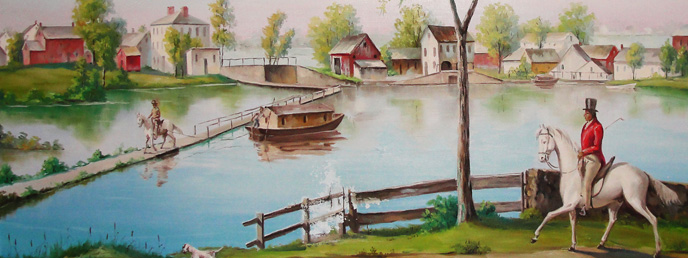


Middlesex Canal Association P.O. Box 333 Billerica, Massachusetts 01821
www.middlesexcanal.org
| Volume 60 No. 1 | October 2021 |
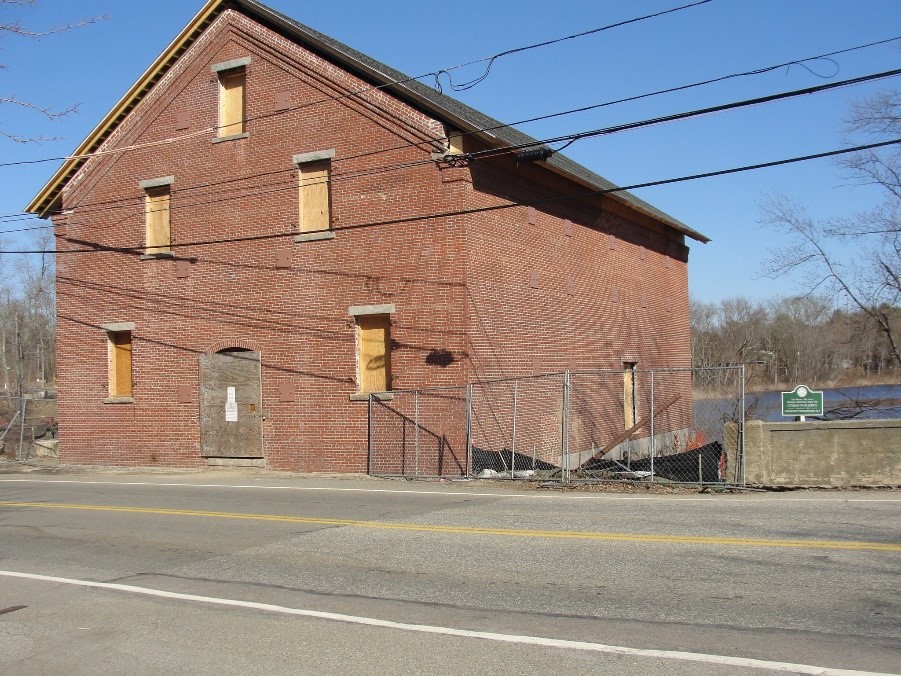
This picture was taken in the spring of 2021. The sign, indicating that some of the funding for the museum project was provided
by a CPA award from the Town of Billerica, is displayed to the right of the proposed museum building.
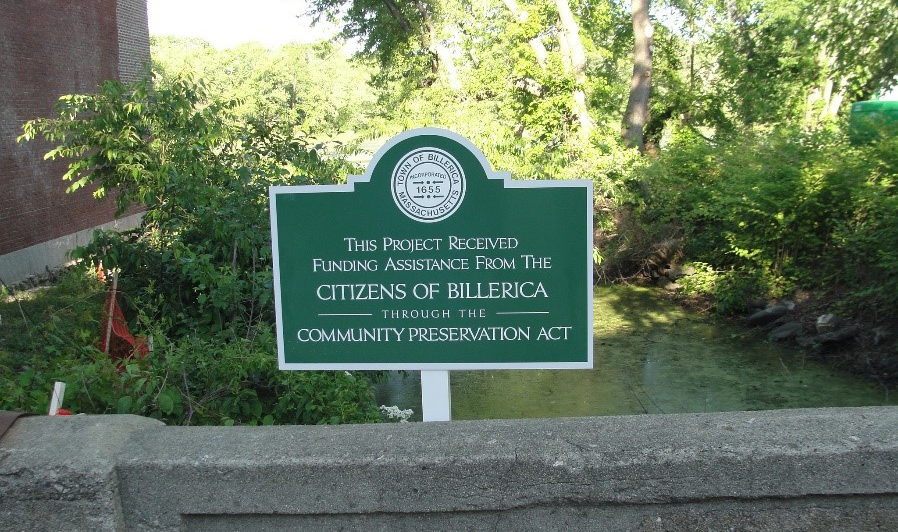
The Town of Billerica Community Preservation Commission (CPA) enables a community to create a local fund to protect its Natural and Cultural
resources, by adding a surcharge to local real estate taxes. In Billerica the surcharge is 1%. The Middlesex Canal Association is proud to have
on full display the CPA Plaque which shows to all passers-by that we are supported by the residents of Billerica.
Please mark your calendars!
MCA Sponsored Events – 2021 Schedule
Fall Walk: 1:30pm, Saturday, October 17, 2021
Meet 1:30pm in the Sandy Beach parking lot, 4 Mystic Valley Parkway, Winchester 01890 (a.k.a. Shannon Beach).
This is a round trip walk of 4 miles on pavement.
Fall Meeting, Sunday, 1:00pm, Oct 24
Dick Hawes, “George E. Mansfield and the Billerica & Bedford Railroad”
Instructions for the Zoom meeting at www.middlesexcanal.org.
The Visitors Center/ Museum is open Saturday and Sunday, Noon – 4:00pm, except on a holiday.
The Board of Directors meets the 1st Wednesday of each month, 3:30-5:30pm, except July and August.
Check the MCA website for updated information during the COVID-19 pandemic.
TABLE OF CONTENTS
MCA Sponsored Events and Directions to the MCA Museum and Visitors’ Center
President’s Message: “Canal Builders of Lowell” - by J. Jeremiah Breen
Annual Meeting Minutes, May 16, 2021 with List of Directors
“Ribbon Cutting Interpretative Panel ‘The Summit Pond and Floating Towpath’” - by Marlies Henderson
“Building Committee Progress Report” - by Betty Bigwood
Boats and Other Floating Objects that Plied the Waters of the Merrimack River and the Middlesex Canal - by Bill Gerber
Interviews extracted from “Massachusetts’ ‘Panama’ Undertaking” Boston Sunday Globe, June 4, 1907 - contributed by Alec Ingraham
Editors’ Letter
October, 2021
Dear Readers!
This issue finds us celebrating the ribbon cutting for the deck of the new Middlesex Canal Museum. It will be the first of many milestones.
Other items of interest include a fascinating contribution by Bill Gerber concerning “objects” on the Canal and the Merrimack River. Much hard work went into researching his report. There is also a reprinted article by the Boston Globe from 1907 found by Alec Ingraham. Interesting how things change, but maybe not so much. … . And, the President’s Message concerns the canal builders in Lowell.
Back in this century, Marlies Henderson and Betty Bigwood have summarized the Ribbon Cutting and the progress of the rest of the museum, respectively. There is also an updated list of Directors included in the Annual Meeting minutes, and lastly, the usual events and directors’ information.
Before closing there are two “future” items to mention. The first is related to our research this past summer reading through old issues of Towpath Topics. In upcoming issues, we would like to reprint some of them and include comments from readers, in the form of updated research or reminiscences of authors no longer with us. We will be contacting you!
The second item relates to the Anniversary of the Museum and Visitors’ Center. We would like readers to submit their favorite memories of meetings, lectures, parties, etc. so we can celebrate together what the space and the people have meant to both organizations (Association and Commission) over the past twenty years.
Read and Enjoy,
Deb, Alec, Robert
MCA Sponsored Events and Directions to Museum
The constantly changing restriction and requirements engendered by the pandemic might force changes in event venues or even cancellations. Anyone planning to attend or participate in the activities listed on the calendar of events should consult the MCA website at www.middlesexcanal.org for up-to-date information.
Fall Walk: On Sunday, October 17th, the MCA will sponsor a canal walk. The walk will begin at 1:30pm at the Sandy Beach parking lot, 4 Mystic River Parkway, Winchester, MA 01890. The walk is four miles round trip on pavement. Leaders: Robert Winters, Jim Winkler
Fall Meeting: The location and/or the manner of presentation (virtual or in person) of this meeting was not available at the time the newsletter was printed. Prior to the date of the meeting pertinent information will be posted on the MCA Website, www.middlesexcanal.org.
Dick’s lecture will cover the history of this notable venture. The Billerica and Bedford Railroad was short-lived and ill-starred, as it was chartered in 1876; opened for service November 28, 1877; and in the hands of Receivers in 1878; and sold in bankruptcy June 6, 1878. (Railroadians of America, New York, Book #4) The line was the first narrow-gauge railroad in America. When the first train departed North Billerica for Bedford, it was celebrated with pride locally and recognized nationally by the Scientific American.
Winter Meeting: The winter meeting will be held on February 20, 2022 at 1:00pm. Details were not available at the time of the printing of this issue of Towpath Topics.
Directions to Museum: 71 Faulkner Street in North Billerica, MA
By Car
From Rte. 128/95
Take Route 3 toward Nashua, to Exit 28 “Treble Cove Road, North Billerica, Carlisle”. At the end of the ramp, turn left onto Treble Cove Road toward North Billerica. At about ¾ mile, bear left at the fork. After another ¼ mile, at the traffic light, cross straight over Route 3A (Boston Road). Go about ¼ mile to a 3-way fork; take the middle road (Talbot Avenue) which will put St. Andrew’s Church on your left. Go ¼ mile to a stop sign and bear right onto Old Elm Street. Go about ¼ mile to the bridge over the Concord River, where Old Elm Street becomes Faulkner Street; the Museum is on your left and you can park across the street on your right, just beyond bridge. Watch out crossing the street!
From I-495
Take Exit 37, North Billerica, then south roughly 2 plus miles to the stop sign at Mt. Pleasant Street, turn right, then bear right at the Y, go 700’ and turn left into the parking lot. The Museum is across the street (Faulkner Street).
By Train
The Lowell Commuter line runs between Lowell and Boston’s North Station. From the station side of the tracks at North Billerica, the Museum is a 3-minute walk down Station Street and Faulkner Street on the right side.
President’s Message – “Canal Builders of Lowell”
by J. Breen
The importance of the Middlesex Canal in choosing the location for the future manufacturing city of Lowell was argued in the January 2015 Towpath Topics.1 With the bicentennial of Lowell’s founding at hand, the Lowell National Historical Park has formed an ad hoc committee with the Middlesex Canal Association on it to consider a program for the celebration of the anniversary. “Irish Canal Builders” is the working title of the program.
Hugh Cummiskey led thirty workers on April 6, 1822, from Charlestown to east Chelmsford, which became Lowell in 1826. Cummiskey came at the invitation of Kirk Boott to dig the Merrimack Canal from the Pawtucket Canal to the Merrimack River. Boott was the agent of the Merrimack Manufacturing Company, and the Merrimack Canal with a water level 32’ above the river would drop water through the mill wheel to power the company’s first mill. The company’s Articles of Association are dated December 1, 1821, the bicentennial date Lowell began as a business. Four months later, the canal was being dug. The first water wheel was set in motion September 1, 1824.
One reason the factory was built and running so quickly was the five owners of the company had the experience of the cotton mill in Waltham which in one year had a 28% return on investment. The owners had made a fortune in Waltham which enabled them to build Lowell without borrowing or stinting. Four of the owners were sufficiently wealthy that they allowed the company machinist to buy ten percent of the company, paying for it from future profits. In 1821, east Chelmsford had an estimated population of 400. In the 1830 census, Lowell had 6,474, a sixteen-fold increase. The machinist owned ten percent of that growth. By 1840, the growth was more than fiftyfold. The industrial revolution had begun.
While the five original owners of Lowell became better off, that is very rich, Kirk Boott, the owner who was their agent in Lowell, had built in the eyes of many a sort of industrial utopia,2 with the workers better off. While today a work week of twelve hours a day, six days a week, living in company boarding house, with the mill bell ringing when to start, to eat, to stop, is too laborious, at the beginning of the industrial revolution, the regularity of factory work in a planned , supervised community was a utopia compared to the Irish canal builders who worked to the vicissitudes of weather and irregular jobs and lived in paddy camps.
Hugh Cummiskey’s came with thirty workers presumably by the smooth, flat route of the Middlesex Canal. Thirty when many more were needed implies Cummiskey chose a vanguard to impress Boott and would fit comfortably in a rented canal boat, 70’ x 9½’.
President James Sullivan of the Middlesex Canal Company was the son of Irish immigrants to New Hampshire who paid for their passage by becoming indentured servants whose indentures were sold on arrival in America. The penniless Irish immigrants had a son who was elected governor of Massachusetts, and the canal packet boat was named the Governor Sullivan. While Cummiskey’s vanguard with their wheelbarrows, picks, and shovels would not fit on the Sullivan and would not have been on the boat, but presumably they passed it on the eleven(?) hour journey between Charlestown and the east Chelmsford landing. The Irish canal builders of Lowell likely heard of James Sullivan, the 1st American canal builder of Irish descent.
Notes
1. Towpath Topics, Vol. 53, No. 2 (Jan 2015), “President’s Message: Location of Lowell”. https://tinyurl.com/yx96xw65
2. Daniel Walker Howe, What hath God wrought: the Transformation of America, 1815-1848 (New York: Oxford University Press, 2007), p. 303.
“Most antebellum utopian communities were not fleeing the industrial revolution. . . . In the eyes of many Americans the mill town of Lowell constituted an industrial utopian community of sorts: a planned and supervised experiment, aspiring to a model role. Still, the most popular utopia of all was simply a family farm. . . . By comparison with what was available in Europe, such a place indeed seemed God’s promise land.”
Daniel Walker Howe is Rhodes Professor of American History Emeritus, Oxford University, and Professor of History Emeritus, University of California, Los Angeles.
Annual Meeting Minutes – May 16, 2021
The annual meeting was hosted over the internet by Howard Winkler in his Zoom meeting room. The chair, J. Breen ex officio, called the meeting to order at 1 o’clock.
J asked if there were any questions from the audience. None being asked, Betty reported for the Nominating Committee that existing officers and directors agreed to continue and Dick Hawes was nominated as a director. Without objection, the nominees were unanimously elected.
The membership secretary submitted a list of members to be elected as proprietors to Traci Jansen. (Neil was on vacation.) Traci read, by MP4, video the names on the new certificates. Without objection, the following members were unanimously elected proprietors:
| Donald Ayer Dinah Borden John Mark Boujoulian Glenn Brewster Arne Buck Dorothea Caplice |
James Corey Ken Cutter Linda A. Delaney Dave & Elizabeth Dingley Linda Jordan Dow Len Dunn |
Paul Early Lisa Fossella Karen Partanen Or. Geoff Gatton Jack Glassman Mr. William K. Goodwin Jr. |
Gail Govertsen Melissa Govertsen Keith Lavon Cindy Neels David Simmons Caroline Waugh |
J gave an illustrated talk on the route of the Middlesex Canal in Lowell.
The chair adjourned the meeting at 3 o’clock. Present were J. Breen, Howard Winkler, Jim Winkler, Tom Dahill, Betty Bigwood, Bill Gerber, Dick Hawes, Doug Chandler, and Andrew Jennings.
MCA Officers and Directors Elected: 2021-2022
J. Jeremiah Breen, President
Traci B. Jansen, Vice-President
Russell B. Silva, Treasurer
Neil P. Devins, Membership Secretary
Howard B. Winkler - Recording Secretary
Betty M. Bigwood, Chair of the Building Committee
Thomas H. Dahill, Jr., Artist in Residence
Roger K. Hagopian, Videographer
Debra Fox, Co-editor of Towpath Topics
Alec Ingraham, Co-editor of Towpath Topics
Robert Winters, Webmaster, Publisher of Towpath Topics
Richard HawesHonorary Directors of the Middlesex Canal Association
Leonard H. Harmon
Howard B. Winkler - Treasurer Emeritus
William E. (Bill) Gerber
19th Annual Bike Tour North
The 19th Annual Bicycle Tour North, sponsored by the Middlesex Canal Association, was held on October 2, 2021. Nineteen riders participated in the event which followed the route of the Middlesex Canal. The tour began at 9:00am at Sullivan Square. By 2:50pm the bicyclists arrived at the MCA’s Museum and Visitor Center in North Billerica and later in Lowell to meet the 3:38pm train back to Boston. For those who enjoy bicycling, this event is highly recommended. Everyone in the picture is smiling even after six hours of bicycling.
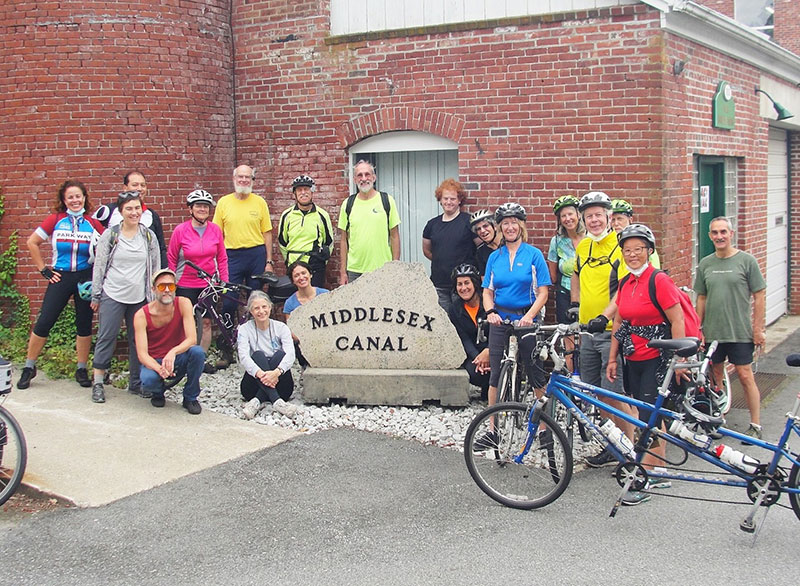
Ribbon Cutting Interpretative Panel
“The Summit Pond & Floating Towpath”
by Marlies Henderson
After the Middlesex Canal Association submitted a SuAsCo (Sudbury Assabet and Concord) Wild & Scenic Rivers Community Grant Application in 2020, the River Stewardship Council awarded their request: $11,500.00 towards construction of an observation deck with a 24” x 36” interpretive sign. The observation deck is part of a larger project to restore the former Talbot woolen cloth warehouse in the North Billerica Historic Mill District, and rehabilitate it for adaptive use as the Middlesex Canal Museum & Visitor Center.
Already, the work-in-progress has lifted up the entire Historic Mill District: Its new roof and repointed brick masonry proudly stand out. When the observation deck was completed this past September, I jumped to promptly organize a Ribbon Cutting occasion for Sunday, October 3, 2021, in partnership with the local access TV station (BATV).
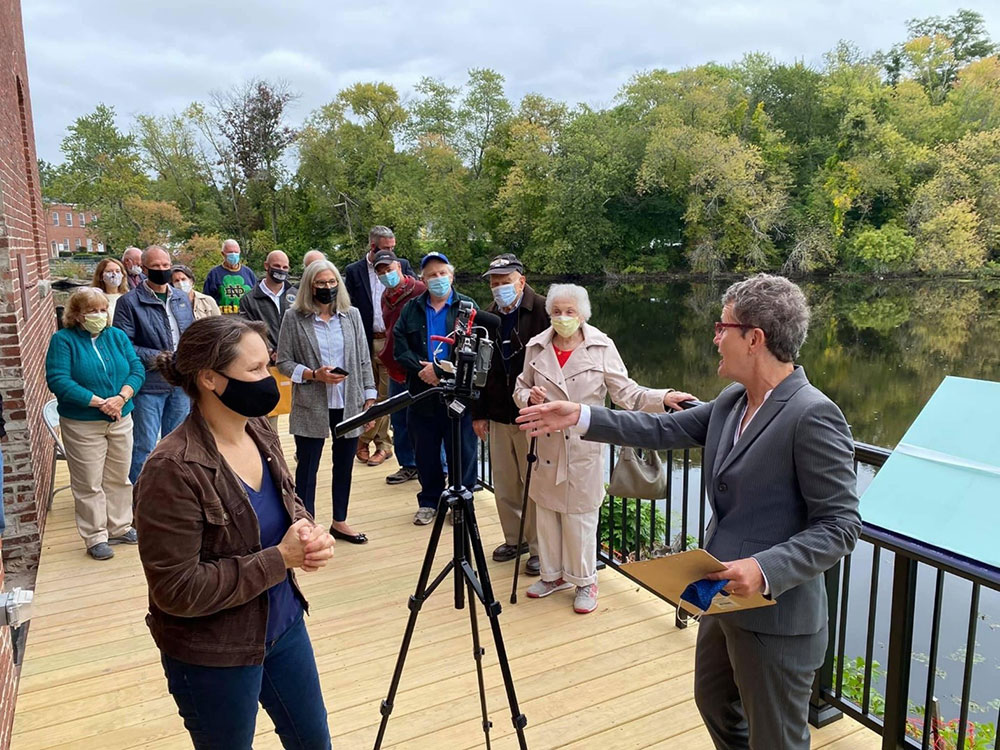
MCA Ribbon Cutting Ceremony – October 3, 2021
In the foreground: Tara Splingaerd, BATV Videographer; and Marlies Henderson, Moderator.
Along the railing (front to back): Lenore Winkler; Howard Winkler, MCA Treasurer Emeritus; Alec Ingraham, Billerica Historical Commission Chair; Al Ramos, Conservation Commissioner; and Andrew Deslaurier, Billerica Select Board.
Center (front to back): Cindy Friedman, State Senator; Marc Lombardo, State Representative; and Paul Hayes, Billerica Conservation Commission Chair.
Along the wall (front to back): Deb Fox, MCC: Billerica Section, BCOA; Dick Hawes, MCC: Billerica Section; Maria Seminatore, Chris Dugan, River Stewardship Council; and J. Jeremiah Breen, MCA President.
At rear raiing: Jamie Doherty: Activities & Volunteer Coordinator (BCOA), Billerica Council on Aging; Diane and Len Harmon, chairman MCC
The format was a first for BATV: A hybrid cablecast with in-person attendees, zoom attendees, and pre-recorded contributions, streamed live through public programming. While we found the rehearsals stressful and nightmarish exercises, the ultimate show proceeded without a hitch nor glitch: Following coronavirus mandates, guests arrived masked, including State Senator Cindy Friedman and State Representative Marc Lombardo. They performed the honors of untying the ribbon bow together, after which I explained the components of the interpretive panel and how the “Summit Pond and Floating Towpath” design had unfolded, making careful mention of the Great Artist Thomas Dahill, fisheries and water resource engineer Laura Wildman, and literary hero Henry David Thoreau who found one of the imaged arrowhead artifacts.
Next, live through zoom, Linda Coombs, program director of the Wampanoag Aquinnah Cultural Center, educated the audience about Indigenous history, culture, and other contributions. Civilization along the North American rivers started, and continues with the Indigenous Peoples.
Then followed two recorded messages: One by Emma Lord, National Park Service Natural Resources Specialist. She spoke on behalf of the SuAsCo Wild & Scenic River Stewardship Council. J. Jeremiah Breen, President of the Middlesex Canal Association, had prepared a recorded presentation about the building restoration project.
Finally, State Representative Lombardo surprised the Middlesex Canal Association President with a Citation, expressing “the hope for future good fortune”. May the House of Representatives second that hope, and send a small fortune to this tiny yet tenacious charitable Association preserving valuable historic heritage for present and future generations!
To see this mingling was truly blissful: Residents of Billerica and beyond, Select Board members, River Stewardship Council members, Middlesex Canal Association members, Historical Board members, Conservation Commissioners, Republican and Democrat legislators, they were all amicably gathered on this observation deck; this patch of common ground, while a contented blue heron watched the ceremony from his perch in the pond.
A recorded production will be available for viewing on the Middlesex Canal website. (www.middlesexcanal.org)
Building Committee Progress Report
by Betty Bigwood
Our progress in 2021 was definitely much slower than we hoped. The Covid-19 virus put a damper on everything with supplies limited or delayed/back ordered. Our contractor Bill Cogley was in competition with the housing market’s “on fire” demand for good carpenters. The Town of Billerica works essentially three days a week with the Town officials taking Friday and Monday off during the summer. This makes for a very slow permitting process.
Brick mason Ed Dolliver arrived home from Florida as promised in early May and started work on the gable ends – May 10th. Our building is not symmetrical and when the perfectly cut brand new roof trusses were placed on top - there were discrepancies which needed to be resolved. When I asked Ed how long he thought he would take he said “two to three weeks” – he actually finished up on June 10th. There was a fair amount to do. Putting up scaffolding and hiring lifts for the men to work ~30 feet up added to the cost. More bricks were needed. Architect Christina McMahon came one morning to add her input. Total cost was $18,345.92.
We asked our electrical contractor, Jusczak Electric, to start the wiring in anticipation of the fascia and soffit work being done. We knew the National Grid, an English Company, takes a couple of months to hook us up to the main current. They put the boxes up both outside and inside and placed some wiring inside but there has been no progress since. Massachusetts will not allow work to be done within 10 ft. of the current so we continue to wait for the soffit/fascia before connecting to the grid. We were billed $16,750. but are withholding $1750. until we are connected to the grid.
Our contractor, Bill Cogley, and his men completed sealing off the roof by placing lengths of wood between the trusses from the inside. There had been concern that pigeons might find access there and start roosting in the attic. Fortunately, that did not happen.
We have a complicated sewer system. There is an in-ground sewer pump and grease trap inside the building which is allowed by the Massachusetts Building Code. Inside the building is under the control of our Architect, Christina McMahon/Caveney Architect & Design. Outside, the long pipe which carries the effluent 300 ft. to the Billerica sewer manhole is under the control of engineer Matt Hamour/Landplex. Christina has subcontracted plumbers and commercial kitchen contractors to submit plans to the Billerica Board of Health/ Kristel Bennett. Matt has submitted several plans to the DPW and now has come to an agreement subject to the Building Department permit, which we await.
Bill Cogley contracted with “All In One & Moore” to insulate the roof with 6.50” of blown in Demilac HL200 insulation which has an R value of 49. A permit to do so was handed in but denied. The Building Inspector required a letter from our structural engineer, Paul Phelan, attesting to the status of our building which was sent. Several letters that Christina wrote required her seal. She is currently filling out forms about things like the number of people allowed in the building etc. We expect to have the permit and work done within the next two weeks once the paper work is completed. The cost agreed to is $22,560. We have given them a 33% down payment ($7500.)
Bill Cogley did not feel he had sufficient knowledgeable men to put up the soffit, so we started looking for someone else to do it. This is a very specialized area and requires expertise. Christina McMahon had used Viking Roofing in NH which she liked and we asked them for an estimate. Bill Cogley said he thought that the cost would be 35-40 thousand dollars. J estimated 50 thousand. So, when the estimate came in we were very taken back – the estimate was $108,000. Much of this cost was for insurance, scaffolding, cranes to reach the area, lifts etc. Christina and Bill discussed ways to limit the cost with Viking Roofing but they came back just a few thousand less. So, Bill and Christina asked the NH Company if they would sell the pre-made painted aluminum to him and they agreed to for $15,000. Bill Cogley has agreed to put up the soffit/fascia in the Spring of 2022. There are other materials to make a soffit so we will consider them over the winter.
On September the 14th the phone rang with those familiar first three digits -508. “Hi Bill I said ‘How are things going?’” “Not so well, I don’t want to alarm you but I fell yesterday and broke my back in four places.” Needless to say I was very alarmed. Bill Cogley is very into safety, precaution and planning detail. This accident was very unusual. Apparently, he was in his warehouse in Whitinsville, Ma. He climbed up a storage rack to retrieve something when the shelving gave way and he fell onto the steel blade of his bull dozer. He was allowed to go home after being seen in the emergency room and was later seen in a spinal clinic. He was told he was very lucky because the damage was done to the transverse projections from his vertebrae and not to the spinal cord. It will take a few months to heal. But we knew nothing else will be done this year.
Our building has pride of place – on the summit pond, adjacent to the Floating Towpath, across from where the first shovels of earth were ceremoniously dug - but no way to see the awesome vista. We needed a deck! It was not unanimous – just think of all the wall space display that would be lost! We needed permission from the Conservation Commission to build in the 25 ft no building wetland zone – why not use a window? Could we afford it - we got a partial Grant. We wanted an exhibit to tell the story- Tom Dahill and Marlies Henderson put their wits together – we have a colorful depiction telling of the site. Jeff O’Rourcke installed the metal posts to support the deck. Bill Cogley and his workers put up the deck floor and railing– there was a deadline of September 30 or we would loose the grant ($11,500.) The Ribbon Cutting was held on October 3rd, 2021. - in full masking, distancing and reduced crowd – but we made it!
Boats and Other Floating Objects which Plied the Waters
of the Merrimack River and Middlesex Canal
by Bill Gerber
The following is an attempt to gather information about the boats and rafts that traversed the upper Merrimack River and the Middlesex Canal in one place and address it as a topic. (Another perspective can be found at https://libguides.uml.edu/c.php?g=524574&p=3586671.)
Luggage Boats
The luggage boats (freighters) were long and relatively narrow, constructed to answer the requirements of river and canal navigation and propelled by multiple means.
Constrained by canal company regulations and the size of the locks, boats “ranged in size from about forty-five to seventy-five feet long and nine to nine-and-a-half feet wide in the middle; a little narrower at the ends, flat bottomed across their full width, but the bottom sloped or rounded up from near the mid-length of the boat, both towards stem and stern so that while the sides were level on top, and about three feet deep at mid-length, they were only a foot or less in depth at either end. A load of about twenty tons would make the boat draw two feet or more, near the middle, while the bottom would be out of water at each end. When the river was low in mid- summer, only about half a full load could be carried to Concord.” 1
“The boats were built of two-inch pine plank, spiked on small oak cross- joists and side-knees [a slice from naturally bent wood, e.g., between a trunk and its roots, or a trunk and a major branch, used to strengthen the corner junctions of every other frame], and had heavy oak horizontal timbers at either end. The sides were vertical and without cross thwarts, except what was called the mast-board; a thick oak plank, securely fastened across the top, from side to side, a little forward of the centre of the boat. The seams between planks were calked with oakum and pitched.” 2
“The mast was a spar about twenty-five feet long and six inches in its largest diameter. A foothold or step was fixed in the bottom of the boat under the cross-plank to receive it, and it was further steadied by the cross- plank, which was slotted to admit it when set up, and had a wedge and staple arrangement to hold it in place. A cross yard, with a square sail attached which could be hoisted or lowered at pleasure by a rope working over a single block in the top of the mast, completed the sailing outfit. It was only used upon the river, the mast being struck and stowed in the boat when passing the larger canals.” 3
 |
| drawing by George Rumford Baldwin - Courtesy, The Winterthur Library: Joseph Downs Collection of Manuscripts and Printed Ephemera, Col. 204 |
| Canal Boat - drawn to scale, top and side views, showing dimensions, and frames, planking, and towing mast and thwart placement |
Shown above is the only known scale drawing of a M’sex Canal Luggage (Freight) Boat from the canal era, drawn by George Rumford Baldwin, Loammi Baldwin’s youngest son and a draftsman/engineer in his own time. It is taken from a book of GRB’s drawings owned by the Winterthur Museum in Wilmington, Delaware.4
This design is not unlike boats built by the Romans two millennia earlier. In the British “Time Team” program entitled “Roman Boat”, see www.youtube.com/watch?v=9ATMSGEu9R4, the discovery of one such boat is discussed and its construction shown (late in the program). Among subtle differences: instead of using slices of knees to strengthen the frame, as M’sex Canal boat builders did, the Romans selected planks from tree trunks that included a branch, and used the natural branch as a brace between the horizontal and vertical frame members. Another difference, the Middlesex boats did not use mortice and tenon joints to bind longitudinal planks together; but Middlesex Canal Aqueducts may have.
The drawing of a Middlesex Canal boat that hangs on the wall near the museum entrance was drawn in the 20th Century by Theodore Haxall. It appears to be his interpretation of a textual description, from the corporate records at the Mogan Center in Lowell, of a boat to be built for the MC Company. The signature on the text is Stephen P. Trevett, it is also signed by Caleb Eddy, Agent for the canal. The drawing is quite representative, but it is not contemporaneous with the canal era. Haxall’s research materials were donated to the Valentine Museum in Richmond, VA.
“The rudder was a long steering oar, [bracketed by thole pins and ] pivoted on the centre of the cross-frame of the stern, the blade, about eighteen inches wide and ten feet long, trailing in the water behind the boat, and the handle or tiller extending about the same distance over the boat, so as to afford good leverage for guiding the unwieldy craft.” 5 An original hangs in the Middlesex Canal Museum.
“Three large scull oars, about sixteen feet long with six-inch blades, and three setting poles, or pike poles as they were sometimes called, stout, straight, round poles, wrought out of tough and springy ash, about fifteen feet long, nearly two inches in diameter and shod at one end with a long iron point, competed the propelling outfit.” 6
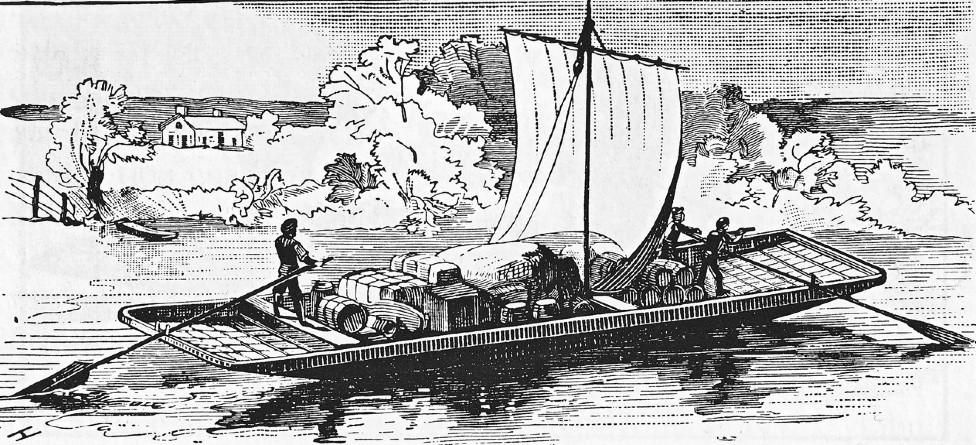 |
| drawing by Allen E. Herrick |
| Canal Boat - rowed and sailed down the Merrimack River |
“The crew consisted of a skipper and two bowmen. In going down the river between canals the usual mode of propulsion was by use of the scull-oars. The bowmen took position close to either side of the boat, facing the bow and about six feet from it, and each worked his oar against a thole-pin placed in the opposite gunwale, the oar handles crossing, so that they were necessarily worked simultaneously. The skipper also had his oar, which he worked in a similar manner when his attention was not wholly taken up in steering. When there was a fair wind the sail would be hoisted. The current also materially assisted on the downward trip, and sometimes the poles would be used.” 7
”On the return trip against the current, the setting poles were the chief reliance, sometimes aided by the sail. The cargo was so piled in the boat as to leave a narrow passage next to each gunwale from the bow to the mast-board. There was also a clear space of six to ten feet left at the bow, and enough at the stern to allow the tiller to be moved freely across the boat.” 8
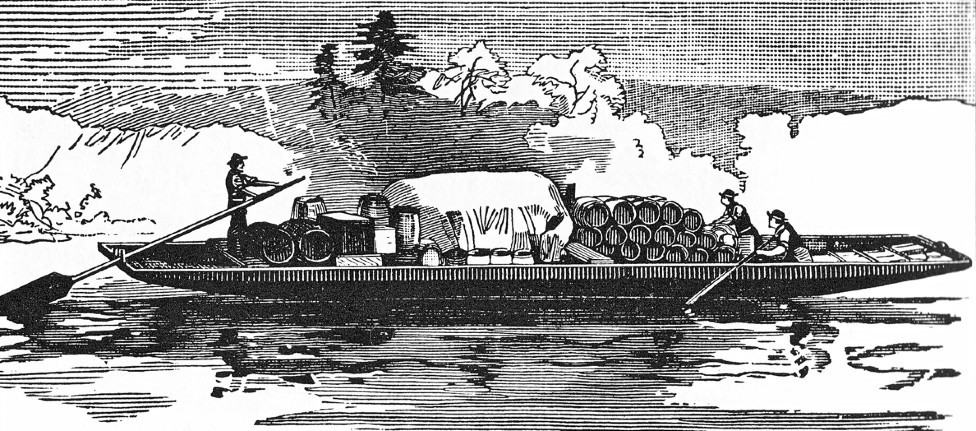 |
| drawing by Allen E. Herrick |
| Canal Boat - poled up the Merrimack River |
“To propel the boat by poling, a bowman stood on either side of the bow, with his face toward the stern, and thrusting the pike end of his pole down beside the boat in a slanting direction toward the stern until it struck the bottom of the river, he placed his shoulder against the top of the pole, and, with his feet firmly braced against the cross-timbers in the bottom of the boat, he exerted the strength of his body and legs to push the boat forward. As it moved, he stepped along the bottom of the boat still bracing his shoulder firmly against the pole until he had walked in this manner to the mast-board, or rather, until the movement of the boat brought the mast- board to him. He then turned round and walked to the bow, trailing his pole in the water, thrust it again to the bottom of the river, and repeated the pushing movement.” The skipper also had his pole, but having very limited space to work in, and being obliged to mind the helm pretty closely in moving against the current, he could do comparatively little to aid the progress.9
These modes of propulsion applied primarily to the river and the river canals. On the Middlesex Canal, the boats were drawn along from the towpath by one or more horses or mules, and if more than one, the animals would almost certainly be harnessed in tandem, not side by side. When under tow on a canal, a shorter towing mast was set into the mast thwart and step, and it was to this that the towline was attached.
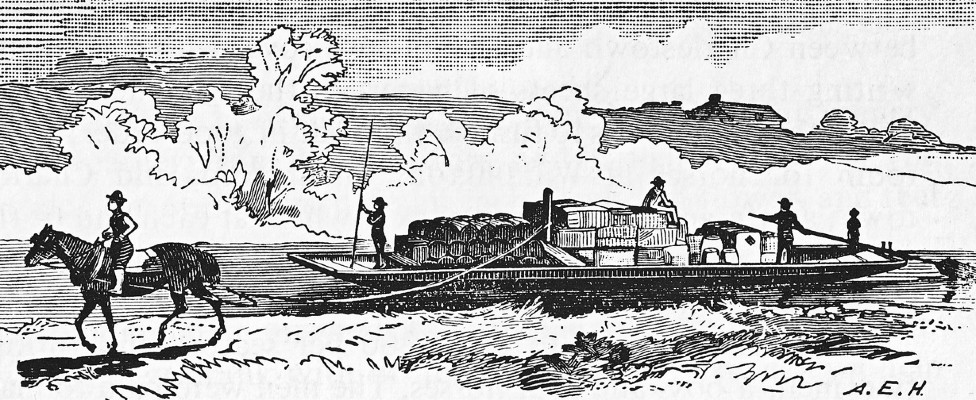 |
| drawing by Allen E. Herrick |
| Canal Boat - under tow along the Middlesex Canal |
Thanks to the preservation instincts of Chuck Mower and the research of Fred Lawson, the Middlesex Canal museum has a towing mast from that era; it hangs there along with a steering oar and a pike pole.
There also are pictures, shown below, of Judge Samuel Hadley’s boyhood model of a MC ‘luggage’ (freight) boat, taken in the early 1930s by Leon Cutler.
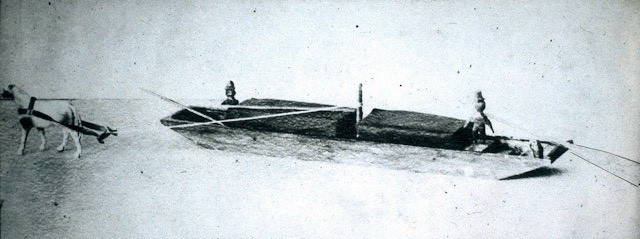
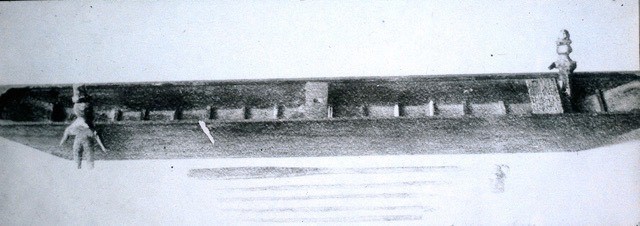
Where is this model today? Lowell Historical Society, perhaps?? Other??
Very little is known about who built boats for use on the canal and river. An educated guess is that there once may have been upwards of 200 boats in regular or occasional service. One boat is known to have been built in Nashua, NH. One graphic of North Billerica shows a boat builder at the southwest corner of the Concord River Crossing. And we know that J.L. Sullivan contracted with one of the boat builders along the Mystic River in Medford for one of his towboats. Thus Billerica and Medford boat builders are likely sources for at least some of the boats.
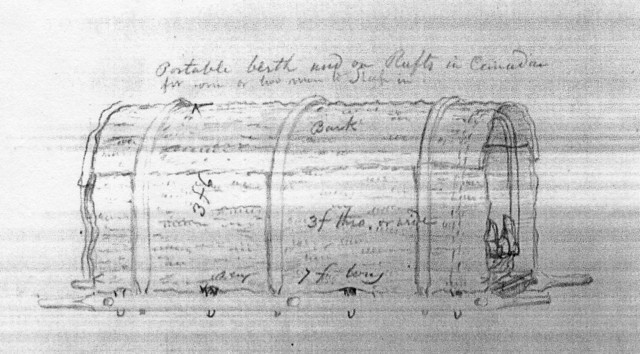 |
| Drawing by George Rumford Baldwin - Courtesy, The Winterthur Library: Joseph Downs Collection of Manuscripts and Printed Ephemera, Col. 204 |
| Portable berth used on Rafts for one or two men to sleep in |
Means to shelter the crews when caught in bad weather on the water is conspicuous by its absence in historical text. Merrimack and Middlesex boatmen and travelers did have the ‘exoskeleton’ of taverns and lock keeper’s houses to duck into whenever possible, but, when not near one of those and the need for shelter arose, it seems rational to think that the crew might rig a tent using the mast, spars and sail with which the Middlesex Canal boats were equipped. Shown above is G.R. Baldwin’s drawing of a similar solution for use on rafts. (Note the protruding feet.)
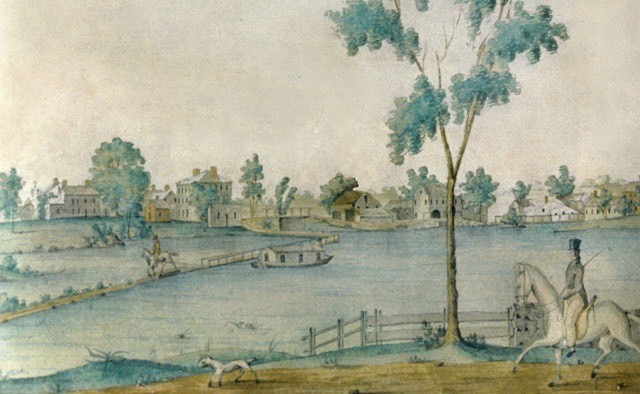
There are other sketches and paintings of MC boats. Shown above is the Jabez Ward Barton painting of a packet-like boat, with a peaked roof, being towed across the Concord River by a horse with mounted rider walking the floating towpath. An extract from this painting has appeared in the masthead of Towpath Topics for many years.
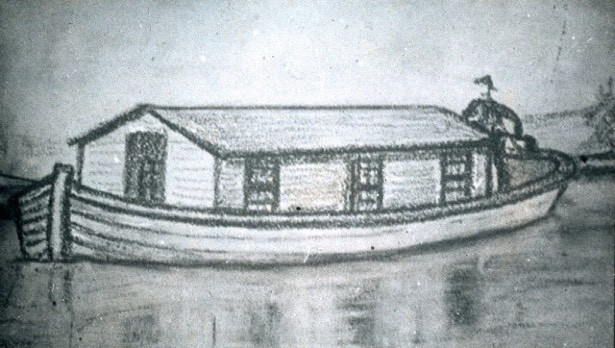
The sketch above, from the Cutler collection, is very similar to, and may have been inspired by Barton’s painting. It may be that the ‘oral tradition’ - that the Packet George Washington had a peaked roof - derives from an assumption that boat in the Barton painting is of that specific Packet under tow. Perhaps it is, but perhaps not; we simply do not know!
There’s also a painting, below, in the collection of the Boston Public Library which, may be of a canal boat being towed out to ship-side in Boston Harbor - perhaps to be loaded with bales of cotton or any other bulk goods that might be better handled that way.
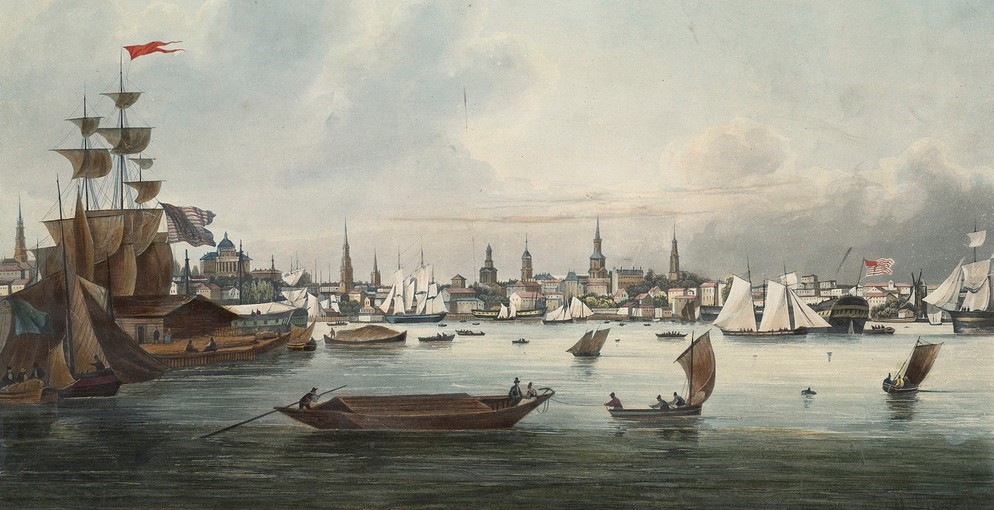
The same shape of boat and load is shown below in a lithograph of Amoskeag Falls and Dam (below, on the left side), at the top level of the Amoskeag Canal. There are many similarities between the two types of vessels which suggests that the boat in the BPL painting is also a canal boat. However, it is also quite conceivable that the boat in the harbor is simply a ‘lighter’, i.e., a flat-bottomed barge or other unpowered boat used to transfer cargos between ships and shore.
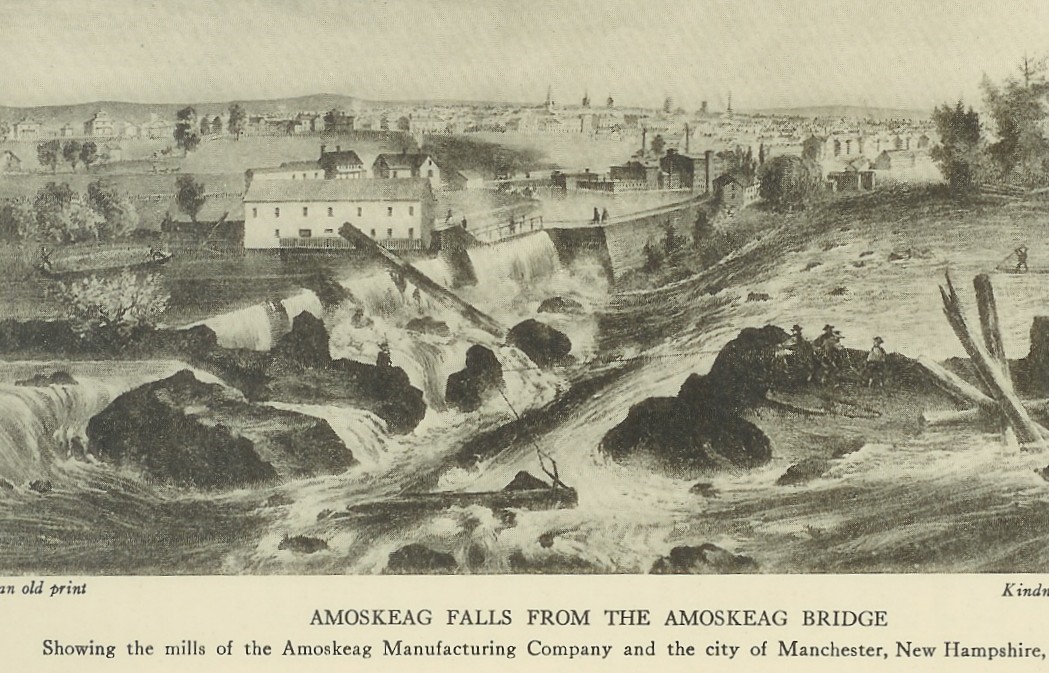 |
| Courtesy of the Manchester Historic Association |
| A lithograph print (1856) of the view from the bridge across Amoskeag Falls by J. B. Batchelder. (1825-1894). |
There is evidence that some of the Middlesex Canal boats found their way downstream to Newburyport and environs, where they were designated “Gundalows” and used to collect river mud and salt hay.10 Thus employed, there was no longer any need for the boats to negotiate locks and so lengthy walking/poling planks were added to either side with a supporting structure between.

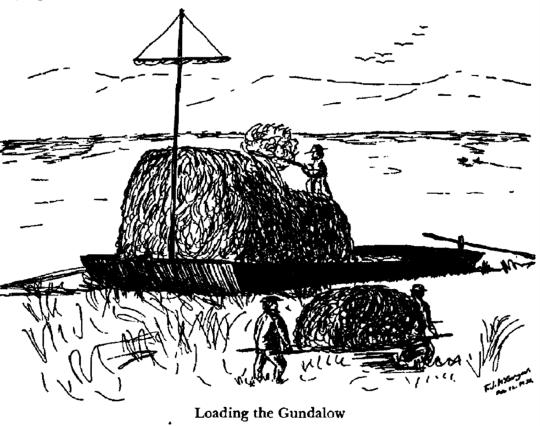
This may have been the destiny of workboats that hauled brick and stone and other material to build mills in Manchester and Lowell, and commercial canal boats as traffic on the canal yielded to the railroads.
Shown below is a drawing by George Rumford Baldwin of a boat, probably from a southern river or canal, showing a partial load of cotton bales.
 |
| Drawing by George Rumford Baldwin - Courtesy, The Winterthur Library: Joseph Downs Collection of Manuscripts and Printed Ephemera, Col. 204 |
| Southern river or canal boat shown with a (partial) load of cotton bales |
Though they were narrower, limited to about 20 to 25 tons, and the height of the load was constrained by the need to fit under all of the bridges along the way, with the same cargo Middlesex Canal boats would have looked somewhat similar.
Canal Packet Boats
Shown below is an 1830 published schedule for a Middlesex Canal Packet. The primary purpose of the Packet, of course, was to conduct the business of the canal, i.e., to provide supplies and essential items to Lock and Landing Keepers, and to transfer the receipts collected from those facilities to the business office. To defray the cost of operation, the Packets also carried passengers and light freight.
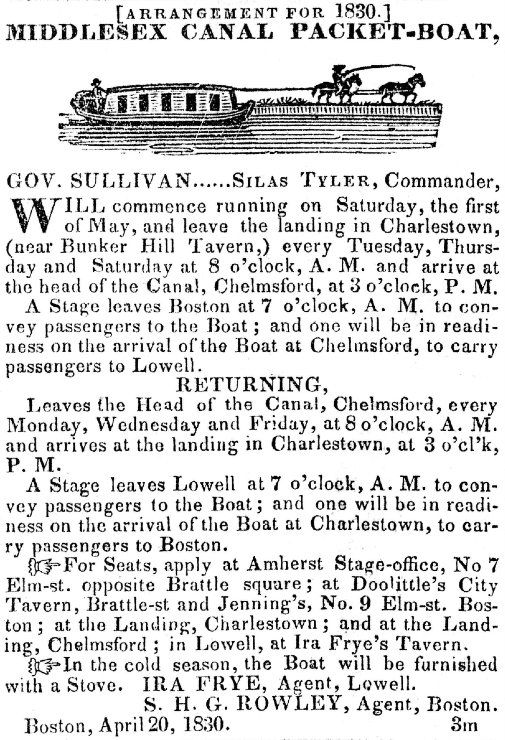
There is only one known drawing of a M’sex Canal Packet that is contemporaneous with the canal era. Shown below, the original of this was once part of the corporate records of the Middlesex Canal archived at Mogan Center in Lowell. Most regrettably the original has since “disappeared”.
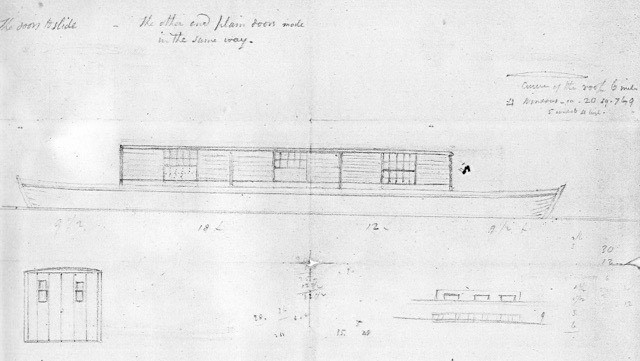
It is likely that Caleb Eddy (“Agent”, i.e., CEO) of the M’sex Canal ordered this boat to replace the Governor Sullivan, which had been in service since the early days of the canal, about 25 years. Another possibility, much less likely, is that this is a drawing of a Packet ordered by J.L. Sullivan for use on the Merrimack River with his 1816 steam towboat; more about that shortly.
If a Governor Sullivan replacement, being a symmetrical ‘double-ender’ there would have been no need to turn the boat around at either end of the canal. All that would be required would be to move the steering oar, if indeed it was steered with an oar, to the opposite end of the boat and change the towline attachment point to a different location on the side of the hull, and the Packet would be ready for the return trip.
Rafts of Logs, and Bands of Rafts
On many rivers across the nation, relatively gently flowing waters permitted timber men to free-float their logs to market. This was not the case on the Merrimack which descended many tens of feet, over many falls and through many rapids before reaching tidewater. Because free-floating logs would be scraped and splintered by these and the Merrimack’s rocky river bottom, timber was floated down-river in rafts, which could be much better controlled.
Shown below is a lithograph from the New Hampshire Historical Society, of a two-raft “band” being steered down the Merrimack. Note that the rafts (aka “shots”) are lashed together using transverse members.12 Also note that the steersmen are situated to move the band back and forth across the river, they are not attempting to propel it; i.e., the raft traveled at the speed of the river current.
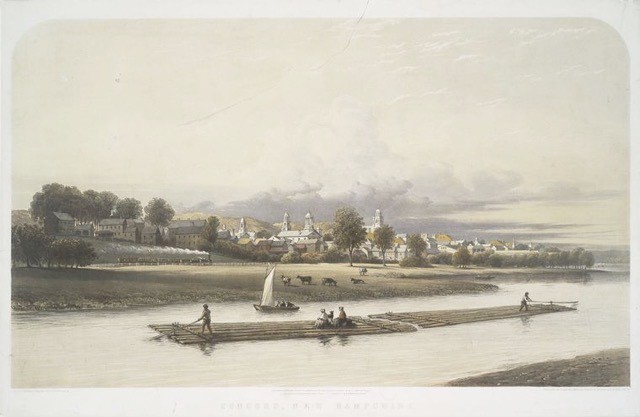
One other Herrick drawing, below, of rafts shows a ‘band’ of three rafts being poled into a stone lock, likely a lock on the Pawtucket Canal. (The Merrimack flight of the Middlesex Canal employed bypass channels to convey water between locks; in contrast, this drawing shows ‘in-gate wickets’ of the type that were used on the Pawtucket.) In this case the rafts are assembled of cut timber, also fastened together with transverse members, though in this case some form of mechanical fasteners are shown. (Likely an Artist’s perception and thus dependent upon the amount of research done.)
 |
| drawing by Allen E. Herrick |
| Rafts being poled into a lock |
Invention and Development of the Steam Towboat
The story of the invention and development of John Langdon Sullivan’s steam powered towboats was published several years ago and is available, on line, at http://middlesexcanal.org/towpath/towpathtopicsFeb2010.htm. Five generations of development and nine physical boats, that can be accounted for, were produced by that effort. These towboats were used, almost exclusively, to move luggage boats, and for a while a Packet, up and down the Merrimack River. Contrary to early interpretations, the towboats were not intended for use on the Middlesex Canal, though they traversed it to and from the river.
Since the above cited article was written, the only new information that has emerged is that the 1816 towboat was mated with a Packet, the concept for the combination of which is probably described in the 1817 patent noted in the cited online article. Linking two independent units kept the dangerous part of the power unit (i.e., the boiler) away from the people and freight.
Most likely, this ‘motor and butty’ arrangement was used to carry passengers and light freight between Middlesex Village and Nashua, though it may have traveled as far down the river as Lowell, and as far up as the villages of Merrimack and Litchfield, NH.
It seems possible that it is this arrangement which the later Steam-Packet, Herald may have replaced around 1834; though no documentation has been found to confirm this! From the book “Origin and Development of Steam Navigation”, by George Henry Prebble, Rear-Admiral, USN:
“1834 The first steamer on the Merrimac River Massachusetts was called the Herald. She was built above Pawtucket Falls, launched in 1834, and made regular trips between Lowell and Nashua, when Lowell had but fourteen thousand inhabitants and Nashua a few hundred. In 1838 [when the railroad reached Nashua] she was lengthened and in 1840 could carry five hundred passengers. She was floated over the falls to Newburyport and taken to New York and run as a ferry boat between New York City and Brooklyn.”
With all due respect to the Admiral, the Herald was not the first steamer to operate on the Merrimack above Pawtucket Falls. At least four of J.L. Sullivan’s steam towboats operated there (one only briefly) almost a quarter century earlier, i.e., from about 1812, on; see “… Sullivan … Towboats”, http://middlesexcanal.org/towpath/towpathtopicsFeb2010.htm.
Footnotes:
1 Stark, General George; “Frederick G. Stark and the Merrimack River Canals”;The Granite Monthly, Volume 9, pp 5 to 8
2 Idem
3 Idem
4 Baldwin, George Rumford, book of drawings; Winterthur Library: Joseph Downs Collection of Manuscripts and Printed Ephemera, Col. 204
5 Stark, General George; “Frederick G. Stark and the Merrimack River Canals”;The Granite Monthly, Volume 9, pp 5 to 8
6 Idem
7 Idem
8 Idem
9 Idem
10 Ordway, Wallace B., “The Merrimack River Gundalow and Gundalowmen,” The American Neptune: A Quarterly Journal of Maritime History, October 1950, p-249 & on.
11 In this case the rafts are not held together using “dogs” (wrought iron staples) cited in the book “The Incredible Ditch”. As told to me by the author, when researching for that book he found an article by Eric Sloan that showed the use of the “dogs”. His assumption is undoubtedly valid, a similar “dog” has been found at a lock on one of the Ohio canals. But it seems unlikely that a raft bound by “dogs” would fare well on a turbulent river.
Extracted from the Boston Sunday Globe Issue of June 4, 1907
gathered by Alec Ingraham
Editors’ note: The interviews with Harlow Colby and Mary A. Carter were extracted from an article entitled “Massachusetts’ ‘Panama’ Undertaking,” which first appeared in the June 4, 1907 issue of the Boston Sunday Globe. Brief biographies of each individual are provided at the conclusion of the quotes. Newspaper articles are not always the most reliable sources. Insight into how some local farmer regarded the canal and an answer to the query “What role did women play in the operation of the Middlesex Canal?” are revealed in the extractions.
I went to Lowell from my native Town of Claremont, N.H. in 1842, says Harlow Colby of East Billerica, and I distinctly remember that the freight boats were still running to Boston over the Middlesex Canal. The boats discharged their freight at Middlesex Village, which was then a small hamlet above the Pawtucket Falls. The Boston and Lowell Railroad was also in full operation at the time.
It was particularly unfortunate for the canal and its stockholders that the iron horse made such an early appearance. The building of the road to Lowell lessened the business of the canal by one third. The subsequent extension of the rails to Concord, N.H. took away another third of the canal traffic, and by 1852 this notable Middlesex County work was out of a job and it was ready in 1859 to surrender its charter.
The canal cost the stockholders an average of $1500 per share. The total receipts, per share, in all the years the canal was in operation were about $500.
Two More Packets
The boats were mostly freight carriers. There were two or more packets, I believe, in the early days before my time, and it was quite a popular custom along the route of the canal to use these packet boats for pleasure parties. The passage fare from Lowell to Boston was 50 cents. The time was four hours, and the trip in pleasant sunny weather was said to be very attractive.
The old Middlesex Canal, however, was mainly of benefit to people up the river to New Hampshire points. The Billerica farmers, for instance, looked askance at the $2 rate per ton of the canal and these thrifty produce market men stuck to their own wagons. The early morning Boston trips were largely taken with oxen teams.
Why I can remember Harvey Crosby of Lowell, who in the old days had two four ox teams on the road from Lowell to Boston for the purpose of transporting general freight. It was a long, wearisome and unexcitable trip. But the goods usually came through by the oxen route in first class condition.
The Bowers Tavern at Billerica Center, now demolished, and which was once my property, continued Mr. Colby, was known some nights to provide entertainment for 50 of these highway freight teams.
One great use of the canal in its palmy days was the floating of lumber rafts from ‘up country’ to the Boston market. These lumber rafts sometimes would be strung together, 12 or 15 of them, and anxious builders in Boston and vicinity were always ready to receive this sort of freight with open arms.
By the provisions of the canal charter the boats could run up the Concord River from North Billerica, where the canal crossed the Concord at grade to points as far as Sudbury. It was a common custom for people living along the Concord River to charter a Boston boat for a round trip thus combining business with pleasure.
The canal, being a public way, was open to boats of any proprietor, whether a canal stockholder or not, and a large number of the craft that glided up and down the placid waters of the old Middlesex were private property of some enterprising individual. A regular system of tolls was provided for these private boats and the owners thereof had to be well freighted both ways to make a trip profitable.
Some of the boats ran up the Merrimac River as far as Concord, N. H. and, of course, horse power had to be substituted, sails, or poling by a large crew. These New Hampshire trips up the Merrimac took as much time as is now required for crossing the Atlantic.
After all that can be said about slowness of this method of transportation, said the venerable citizen of Billerica, it was possibly a mistake to have permitted this Middlesex Canal to have become an abandoned way. There may have been business enough in the freighting of large bulky articles or in the one item of carrying coal to have kept the former pride of Middlesex in a profitable condition. At any rate, it was a great achievement in its day.
I can well remember the boats of the Middlesex Canal, said Mrs. Mary A. Carter of Wilmington Center, as I was living in my young girlhood with Daniel Gowing, who was the keeper, or the attendant, of the canal locks that were located across the street from my present home.
The locks house or tavern, which was the Gowing home at the time of which I speak – say 1852- is still standing near the bank of the old canal. This house was built by the company for entertainment of the boatmen and raftsmen on the canal. The place was not really a country inn. The canal men always had the right of way. The occasional traveler had to take his chances for accommodations after regular patrons of the place had received attention.
In the prosperous days of the canal, before the railroad was built, the lock house was kept by Josiah Gillis. After Mr. Gillis died, the widow, who was Mary Stark of Manchester, the granddaughter of Gen. John Stark, had the management for many years. It was then known as the ‘Widow Gillis tavern,’ although as has been said the establishment was not strictly speaking a place of indiscriminate public entertainment.
Blowing of a Horn
All the boats and rafts had to stop at Gillis locks, and it was always the custom for one boatman to signal his approach to the locks by the vigorous blowing of a horn. For the people who prepared the meals this horn-blowing was also a notice that some hungry men would soon be looking for expected meals. As the boats and the rafts were coming and going all the day long, the business in the kitchen of the old ‘lock houses’ was lively enough to keep us from getting lonesome.
The boats were always tied up during the night time, continued Mrs. Carter, as also during the winter months. But while navigating season was prevailing all the lock houses were busy places for those who lived in them. The boats ran upon no regular schedule. They appeared whenever they could make the trip. The load down to Boston would be wood. Coming back the principal part of cargo would be coal for the mills at Lowell and Nashua and points beyond.
On the Merrimac River the boats would be obliged to dispense with horses and use the great oars at both the bow and the stern. Sometimes, with a fair wind blowing, sails would be hoisted, and the Merrimac River would present a picturesque appearance of boats and rafts upon its surface.
The next lock below us was in Woburn Center, one of the long levels, while above was Nichols lock, barely a mile away. Near the Nichols lock was the lock house., now destroyed, and also what had been known in recent years as King’s tavern.
King’s Tavern, one of the notable dwellings in Billerica, is located on the main road between Billerica and Wilmington, and is, at least, 150 years old. It was the home of Jeremiah Allen in 1776, before the advent of the canal by many years.
At the time of the running of the canal, in full trade of its business, King’s tavern was kept by Henry Allen, the son of the Allen mentioned. In later years the house became the home of Samuel King. As Mr. King resided in the tavern, ‘years after the stopping of the canal and the beginning of the railroad era,’ it was not probable that the character of the place was maintained to any great extent after the King’s occupancy.
About the first man to navigate the canal, concluded Mrs. Carter, was John Wilson of Middlesex Village. I remember Caleb Eddy, the manager, as also the numerous pleasure parties that would charter one of the boats for a day’s outing. All the water would be drawn from the canal bed in the fall of the year. In April, or as soon as freezing weather was gone, back again would come the water and with it the hustle and bustle of many visitors. One year the canal was full of alewives, and we had fresh fish until we were tired of the dish. Occasionally, too, the water in the canal would flood the adjourning lands. Muskrats were largely responsible for the leaks and the company offered bounties for their tails. However, we all thought the canal a benefit to the people about here in many ways. And the question frequently arises, ‘Why not revive the old waterway?’
Harlow Colby was born in Hopkinton, New Hampshire in 1824. He married Abbie Joy in Lowell in 1847. He passed away at the home of a relative in Swampscott in 1913. He worked as an overseer in the Lowell mills and later as a tavern keeper and a farmer in East Billerica.
Mary Ames was born in Wilmington, Massachusetts in 1833. In 1855 she married Edward Carter, who at one time worked for the railroad and later was employed as a carpenter. She was among the first women in Wilmington to register to vote for school committee candidates. One of her precious memories was, along with her sister, feeding the men who worked in Canal. She maintained a sizeable library and kept up on current events by reading magazines and newspapers. She was reportedly keen of mind in her old age. She lived in “the Canal House” the portion of which was moved across the street. When moved, part of the lock chamber served as the house’s foundation. She fondly would say she never traveled on the canal but her mother did. She died at the home of a relative in Burlington in 1923 just short of her 91st birthday.
MISCELLANY
Back Issues - More than 50 years of back issues of Towpath Topics, together with an index to the content of all issues, are also available from our website http://middlesexcanal.org/towpath. These are an excellent resource for anyone who wishes to learn more about the canal and should be particularly useful for historic researchers.
Estate Planning - To those of you who are making your final arrangements, please remember the Middlesex Canal Association. Your help is vital to our future. Thank you for considering us.
Membership and Dues – There are two categories of membership: Proprietor (voting) and Member (non-voting). Annual dues for “Proprietor” are $25 and for “Member” just $15. Additional contributions are always welcome and gratefully accepted. If interested in becoming a “Proprietor” or a “Member” of the MCA, please mail membership checks to Neil Devins, 28 Burlington Avenue, Wilmington, MA 01887.
Museum & Reardon Room Rental - The facility is available at very reasonable rates for private affairs, and for non-profit organizations to hold meetings. The conference room holds up to 60 people and includes access to a kitchen and restrooms. For details and additional information please contact the museum at 978-670-2740.
Museum Shop - Looking for that perfect gift for a Middlesex Canal aficionado? Don’t forget to check out the inventory of canal related books, maps, and other items of general interest available at the museum shop. The store is open weekends from noon to 4:00pm except during holidays.
Nameplate - Excerpt from an acrylic reproduction of a watercolor painted by Jabez Ward Barton, ca. 1825, entitled “View from William Rogers House”. Shown, looking west, may be the packet boat George Washington being towed across the Concord River from the Floating Towpath at North Billerica.
Web Site – The URL for the Middlesex Canal Association’s web site is www.middlesexcanal.org. Our webmaster, Robert Winters, keeps the site up to date. Events, articles and other information will sometimes appear there before it can get to you through Towpath Topics. Please check the site from time to time for new entries.
The first issue of the Middlesex Canal Association newsletter was published in October, 1963.
Originally named “Canal News”, the first issue featured a contest to name the newsletter. A year later, the newsletter was renamed “Towpath Topics.”
Towpath Topics is edited and published by Debra Fox, Alec Ingraham, and Robert Winters.
Corrections, contributions and ideas for future issues are always welcome.

State Representative Marc Lombardo (left), Moderator Marlies Henderson (Left of Center) and State Senator Cindy Friedman (right) unveil the Middlesex Canal Summit Pond & Floating Towpath interpretative panel at the MCA Ribbon Cutting Ceremony on 10/03/2021.
Photograph courtesy of Mary Leach.
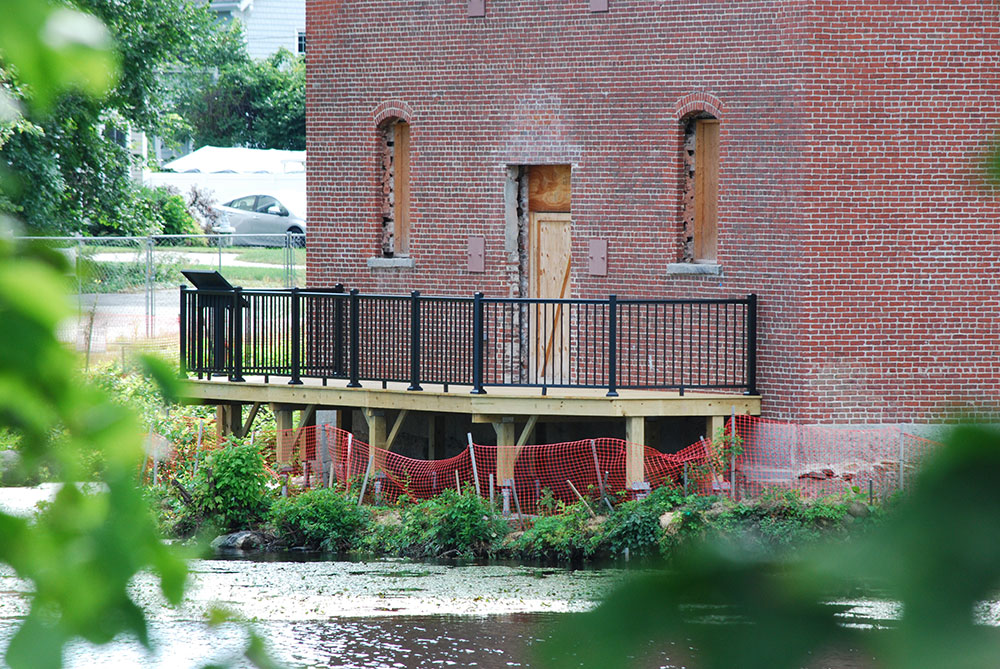
View of the Museum deck from the Concord River